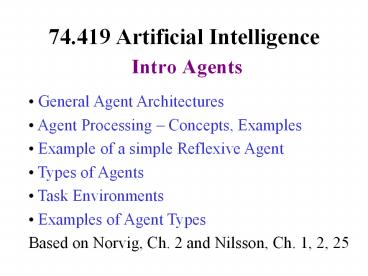74.419 Artificial Intelligence Intro Agents PowerPoint PPT Presentation
Title: 74.419 Artificial Intelligence Intro Agents
1
74.419 Artificial Intelligence Intro Agents
- General Agent Architectures
- Agent Processing Concepts, Examples
- Example of a simple Reflexive Agent
- Types of Agents
- Task Environments
- Examples of Agent Types
- Based on Norvig, Ch. 2 and Nilsson, Ch. 1, 2, 25
2
Agent Architecture (Norvig)
sensor data ? perception ? cognition ? reasoning
goal setting, re-evaluation of goals planning
learning ? action selection ? action
performance ? motor control
3
Agent Processing
sensor data speech signal, image,
... perception phonemes, visual objects,
... cognition concepts (language or visual)
reasoning conclusions, generalization goal
setting evaluation priorities, utility
function planning from goal to set of actions
action selection execution control action
performance motor control transform high-level
actions into low-level robot actions learning
perceptual, conceptual, plan level
4
Example 1 Mother hears her Baby cry.
sensor data - soundwave, auditory
input perception - some squeaky noise baby
scream cognition - my baby cries reasoning -
I hope she is okay. She is hungry. goal
setting, evaluation - I have to see the doctor
with her. We have to move to another city.
... action / plan selection - go feed
her planning - drop laundry, walk upstairs, feed
her action selection - drop laundry action
performance - open hand motor control - move
fingers in certain position
5
Example 2 Taxi Driver sees Stop sign.
sensor data - light waves, visual
input perception - red sign with some letters
cognition - STOP sign reasoning - I have to
stop. I will be late. goal setting,
evaluation Stop the car Next time Ill take
the other route. I quit my job. action / plan
selection - stop and wait watch traffic action
selection - hit the brakes, ... action
performance - move right foot on brake pedal
motor control - move foot along a trajectory
until it rests on the brake pedal apply certain
force
6
Agents Speech Processing
Speech Signal preprocessing sampling,
digitizing, filtering sensory data digitized
sound wave perception frequency analysis,
feature extraction, phoneme/word recognition
cognition baby cries
7
Agents Visual Processing
Visual Images preprocessing digitization,
filtering, sensory data digitized
bitmap perception feature extraction,
classification, object recognition cognition
stop sign
8
Agents Effector/Actuator Control
Motor Control selection of (intentional) actions
based on state and goal evaluation (utility
function) reflexive / reactive behaviour
action without thinking action performance
transform (higher level) action commands into
agents basic actions motor control commands
for agents basic action repertoire, e.g. move
grasper to point
9
Agents Proprioception
Connecting Sensory Input and Motor
Control proprioception delivers sensory
information on agents internal physical state,
e.g. angles of joints of limbs used in planning
and performing (motor) actions and to provide
feedback for motor control (also for other
physiological processes like hunger, thirst)
10
Agent Architectures (Nilsson)
- Nilsson, Figures 25.2 and 25.3, p. 446-7
11
Agent Architecture (Nilsson)
12
Agent Planning Architecture (Nilsson)
13
Types of Agents (Norvig)
- Depending on the complexity of the behaviour
function (i.e. the percept action mapping) - simple Reflex Agents (low-level behaviour
routines) - Agents with Memory (world states)
- Agents with Goals (search, planning)
- Agents with Utility Function (decision between
goals)
14
Simple Reflex Agent Example (Nilsson)
- Robot in Maze
- perceives 8 squares around it
- low-level percept can robot move to square or
not - higher level percept 2 unit segments
- 4 basic actions left (west), right (east), up
(north), down (south) - task is to move along a border
- no 'tight' spaces, at least two free squares
15
Simple Reflex Agent - Example (Nilsson)
Note The description of the left bottom agent
seems to be wrong. This agent will walk clockwise
along the outside wall.
Note The description of the left bottom agent
seems to belong to this agent. It will walk
counter- clockwise around the object.
16
Simple Reflex Agent - Example
17
Simple Reflex Agent - Example
Behaviour Routines If x11 and x20 then move
right If x21 and x30 then move down If x31 and
x40 then move left If x41 and x10 then move up
else move up
18
Task Environments (Norvig)
- Depends on task, environment, and sensors
- fully observable vs. partially observable
- video camera in bright room vs. infrared camera
- deterministic vs. stochastic vs.
non-deterministic - assembly line vs. weather vs. odds gods
- episodic vs. non-episodic
- assembly line vs. diagnostic repair robot,
Flakey - static vs. dynamic
- room without vs. with other agents
- discrete vs. continuous
- chess game vs. autonomous vehicle
19
Infrared Picture of an Unpleasant Situation
copied from www.indigosystems.com
20
Examples of Agents (Norvig)
21
Robotic Sensors
- (digital) camera
- infrared sensor
- range finders, e.g. radar, sonar
- GPS
- tactile (whiskers, bump panels)
- proprioceptive sensors, e.g. shaft decoders
- force sensors
- torque sensors
22
Robotic Effectors
- limbs connected through joints
- degrees of freedom directions in which limb
can move (incl. rotation axis) - drives wheels (land), propellers, turbines (air,
water) - driven through electric motors, pneumatic (gas),
or hydraulic (fluids) actuaction - statically stable, dynamically stable
23
Describe Flakey
- Sensor Equipment?
- Action Repertoire?
- Task Environment?
- Perceptions and Cognition?
- Goals? Intentions?
- Type of Agent?

